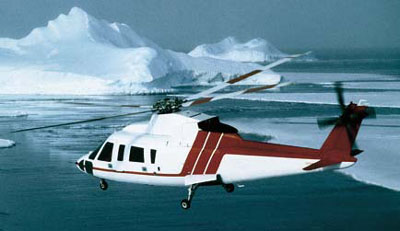
The pilot of a Sikorsky S76 helicopter was left with only
lateral cyclic control when a loose screw lodged at the base of the
cyclic stick.
During transition from normal cruise flight to the approach to
land the pilot found that the cyclic could not be moved aft. He
also found that with any further forward movement of the cyclic
stick it could not be moved aft of the new position.
The pilot froze the cyclic longitudinal position and the
helicopter stabilised in a level pitch attitude at about 85 knots
indicated airspeed. Using only lateral cyclic movements to
manoeuvre the helicopter, the pilot conducted an 80-knot run-on
landing on the runway at Barrow Island. A run-on landing utilises
the aircraft's weathervane effect to streamline the fuselage until
landing.
An inspection discovered that a panhead type screw was lodged at
the base of the cyclic stick. The screw had lodged between the
lower protrusion on the casting on the end of the cyclic stick
torque tube and the lugs on a support bracket.
The cyclic stick base hardware is accommodated in a tub-like
area formed by the cabin structure supports. A leather boot mounted
at the base of the cyclic normally prevented foreign objects from
entering the tub. Further inspection found the leather boot on this
helicopter to be intact. With the boot in place, the only possible
entry points for a screw is through a rigging pin hole in the aft
mid-height position of the boot-halves joint, or vertically through
an opening provided for the cyclic stick electrical wiring
loom.
It was unlikely that the screw would have entered the tub area
with the boot fitted. It was more probable that it was introduced
during previous maintenance when the boot was removed.
After this incident and a similar incident experienced by
another Australian S76 operator in 1995, an ATSB investigation was
begun. The operator issued an alert message for its fleet of S76
helicopters to undergo an inspection of the subject area. A defect
report was also submitted to the Civil Aviation Safety
Authority.
The ATSB worked with the manufacturer to develop an acceptable
solution that would eliminate the hazard.
The manufacturer conducted a design engineering review of the
cyclic stick base hardware. It was agreed that an engineering
design change, although extensive in nature, would more effectively
reduce the effects of human factor maintenance error in this
area.
The manufacturer advised that a field modification of the
pilot's side bracket was being prepared to increase the gap between
the torque tube rig boss and the bracket foot.
In October 1999, the manufacturer issued Alert Service Bulletin
76-64-44 outlining an inspection for foreign objects and procedures
to modify both the composite controls cover and the cyclic stick
support tube assembly. These modifications eliminate the foreign
object interference problem.


